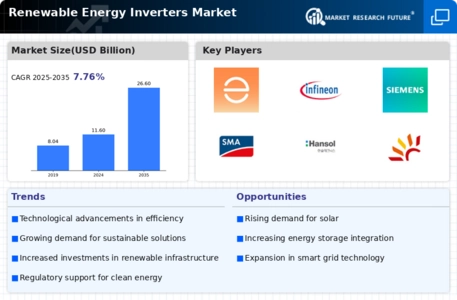Top Industry Leaders in the Renewable Energy Inverters Market
*Disclaimer: List of key companies in no particular order
Top listed global companies in the Renewable Energy Inverters industry are:
KACO Group, Ingeteam Power Technology S.A., General Electric, TMEIC, Schneider Electric, SMA Solar Technology AG, Bonfiglioli Transmissions Private Limited, Danfoss, Eaton, Emerson Electric, Enphase Energy, Fronius International GmbH, Mitsubishi Electric Corporation, REFU, and Riello Elettronica Group.
Bridging the Gap by Exploring the Competitive Landscape of the Renewable Energy Inverters Top Players
The global renewable energy inverter market is projected to witness a stellar rise, driven by the burgeoning adoption of solar, wind, and other renewable energy sources. This surging demand has ignited a fierce competition among established players and innovative newcomers, each vying for a larger slice of the pie. Let's delve into the key strategies, market share dynamics, and emerging trends shaping this dynamic landscape.
Key Player Strategies:
Market Leaders: Established giants like Sungrow, Schneider Electric, and Huawei are leveraging their extensive product portfolios, robust R&D capabilities, and global distribution networks to maintain their dominant positions. They are actively acquiring smaller players and forging strategic partnerships to expand their reach and technological edge.
Regional Specialists: Companies like Ingeteam (Spain) and Fronius (Austria) are capitalizing on their strong regional presence and deep understanding of local regulations to carve out lucrative niches. They tailor their offerings to specific market needs, often specializing in high-efficiency inverters or those suited for challenging grid conditions.
Technology Disruptors: Agile startups like Enphase and SolarEdge are pushing the boundaries of innovation with microinverters and smart inverter technologies. Their focus on modularity, distributed generation, and cloud-based monitoring solutions is attracting tech-savvy customers and challenging traditional centralized inverter systems.
Market Share Analysis:
Product Type: String inverters currently hold the lion's share of the market due to their affordability and ease of installation. However, central inverters still maintain a strong presence in large-scale utility projects. The market is witnessing a gradual shift towards microinverters and hybrid inverters, driven by growing demand for distributed generation and grid-interactive capabilities.
Application: The residential segment is booming, fueled by government incentives and rising energy costs. However, the utility-scale segment remains a lucrative battleground, with players vying for contracts in large solar and wind farms. Industrial and commercial applications are also gaining traction, particularly for rooftop solar installations.
Geography: Asia Pacific, led by China and India, accounts for the largest share of the global market. However, Europe and North America are also significant players, with mature markets and a focus on grid modernization. Regional variations in renewable energy policies and grid infrastructure create unique opportunities and challenges for different players.
New and Emerging Trends:
Artificial Intelligence (AI): AI-powered monitoring and optimization systems are being integrated into inverters to improve efficiency, predict maintenance needs, and enhance grid stability. This trend is driving demand for smart inverters that can seamlessly integrate with the smart grid of the future.
Energy Storage: Inverters are evolving to play a crucial role in energy storage solutions, enabling seamless integration of solar and wind power with battery systems. This opens up new revenue streams for inverter manufacturers and creates a more resilient energy infrastructure.
Microgrids: The growing adoption of microgrids in remote areas and disaster-prone regions is boosting the demand for modular and flexible inverter solutions. These inverters need to be able to island from the main grid and operate independently, creating opportunities for specialized players.
Overall Competitive Scenario:
Success in this dynamic landscape will hinge on a combination of factors, including product portfolio diversification, geographical expansion, technological leadership, and strategic partnerships. The ability to cater to specific market segments and adapt to evolving trends will be critical for players to stand out and secure their place in this high-growth market.
Latest Company Updates:
KACO Group:
- Jan 12, 2024: Announced partnership with SolarEdge Technologies to offer hybrid inverter solutions for the European market. (Source: KACO Group press release)
- Dec 15, 2023: Launched bluePHOENIX string inverters with extended power ranges and improved efficiency. (Source: KACO Group website)
Ingeteam Power Technology S.A.:
- Jan 10, 2024: Unveiled new INGECON SUN 3S string inverters for distributed generation projects. (Source: Ingeteam website)
- Nov 22, 2023: Secured a contract to supply 1.8 GW of PV inverters for a solar farm in Brazil. (Source: Ingeteam press release)
General Electric:
- Jan 5, 2024: Showcased its latest Solis string inverters at the Australian Solar Council's annual conference. (Source: Renewables Now)
- Oct 26, 2023: Partnered with Sungrow Power Supply Co. Ltd. to develop and manufacture high-power PV inverters for the Chinese market. (Source: GE Renewable Energy press release)
TMEIC:
- Dec 28, 2023: Successfully commissioned a 100 MW solar PV plant equipped with its PV inverters in Japan. (Source: TMEIC website)
- Sep 15, 2023: Received an order for 200 MW of PV inverters for a solar project in the United States. (Source: TMEIC press release)









